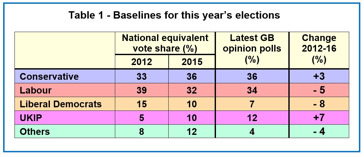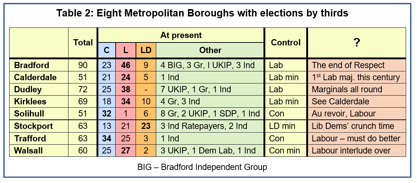Chris Game
My previous elections preview tabulated all the local, regional and even parliamentary elections taking place on Thursday 5th May. This preview focuses on just the top two-line entry in that table: the 36 English metropolitan boroughs, 32 of which are electing one third of their councillors, and three their whole councils. In fact, the focus is narrower still – on just eight councils where even these partial elections could for various reasons prove more than averagely interesting.
With some senior Labour figures prepared to delude themselves that, if only it weren’t for Corbyn, Labour would be “absolutely steaming ahead” with a 15-point lead in the local elections, it’s worth putting some actual figures on the main parties’ starting positions. In around 60% of these contests the councillor elected four years ago will be seeking re-election for the same ward. But in all cases those 2012 election results, for both the whole council and individual wards, provide the baseline against which to assess the parties’ prospects this time. The other comparison used, also included in Table 1, will be 2015, the last time most of these wards will have held elections.

May 2012 was, as the table testifies, one of the few candidates for Ed Miliband’s finest hour. George Osborne’s ‘omnishambles’ budget (attempted taxes on pasties – sorry, hot baked goods – and holiday caravans), Abu Qatada’s botched deportation, and open dissent within the Coalition combined to hit the Conservatives first in the opinion polls and then in the real ones. Boris Johnson was re-elected London Mayor ahead of the Olympics, but Labour were the clear overall winners, gaining a net 860 council seats and majority control of 32 new councils, including Birmingham, Derby, Dudley, Exeter, Norwich, Plymouth, Southampton, Cardiff and Swansea.
Now, though, the electoral cycle wheel has turned full circle, and these councils and seats are the ones Labour is defending. The Conservatives’ months-long and substantial lead in the polls may virtually have disappeared, but they’re still left with a roughly 4% two-party swing in their favour since 2012.
Of course, plenty of other potentially influential things have changed too: the rise of UKIP and collapse of Lib Dem support, though neither evenly across the country; four years of austerity policies and public service cuts; unfreezing of council tax; the Government’s schools policies; and the small matter of the overlapping EU referendum. The 2012 base, though, is the only one that’s close to measurable, so no apologies for using it.

BRADFORD was one of three West Yorkshire metropolitan boroughs, along with Calderdale and Kirklees, that spent most of New Labour’s period of government at Westminster as hung councils. It was the first to return to Labour control (just) in 2014, and might have done so in 2012, had George Galloway’s shock parliamentary by-election victory for the Respect Party not enabled the election of five Respect councillors shortly afterwards on his proverbial coattails.
The Respect Five’s contribution to the city’s local government proved seemingly more short than sweet, entailing splits both amongst themselves and with Galloway – over the prioritisation of his mayoral candidacy in London – and flirtations with independence (the Bradford Independent Group listed in the table). None appear to be defending the wards they won in 2012, all of which Labour took easily last year. The Lib Dems presumably hope to recapture some of the wards they lost in 2011 and 2012, but will need to advance considerably more than the polls suggest they have.
CALDERDALE could follow Bradford back to Labour majority control, but only if the party improves on last year’s performance. It regained the minority control it lost in 2014, following a Conservative-Lib Dem vote of no confidence in the leadership of Tim Smith, but with fewer council seats. The Lib Dems withheld their backing from either big party and a contrite and more consultative Smith returned as Council Leader. But, of the 10 wards Labour is defending from 2012, three were won last year by the Conservatives and one by the Lib Dems.
DUDLEY Conservatives in 2012 saw eight years of rule ended dramatically as Labour took 12 of their seats, UKIP’s single seat, and with them comfortable overall control of the council. Two years later, only slightly less dramatically, UKIP returned with a vengeance, winning six of Labour’s seats plus one Conservative. Despite a 23% vote share, it didn’t add to that total in 2015, but Rotherham is the only met borough with a larger UKIP representation.
Clearly, aided nowadays by the absence of Lib Dems, Dudley has more Labour-Conservative marginal wards than average, and this time Labour is doing most of the defending – against both the Conservatives and UKIP. A Labour to Conservative swing of 5% since 2012 – just over what the polls suggest has actually occurred – could see the Tories back again as the largest party.
KIRKLEES, with its strong third party representation, has seemed the most resolutely hung of the three West Yorkshire mets, but today’s Lib Dem group is half the size it was what it was in 2010 when the party entered into national coalition. As the main opposition party at Westminster, Labour’s task of winning the additional seat needed for a majority shouldn’t be that difficult, but one of the 12 wards it’s defending this time was lost badly to the Conservatives in 2015, so it could well be thwarted once again.
SOLIHULL boasts easily the largest Green group among the mets, and its steady rise to becoming the main opposition party, helped by periodic Lib Dem defections, has been the local electoral story of recent years – until 2015. In those elections it failed to pick up the third seats in wards it had won in previous years, and in August the first Green councillor not just in Solihull but in the West Midlands region decided to become a Social Democrat.
Any Green setback, though, is a blip compared to the waning of Labour, who 20 years ago were embarking on a three-year period of minority control. This year the party’s sole remaining councillor is defending her seat in a ward taken last year by UKIP.
STOCKPORT Lib Dems ran the council for nearly 10 years as a majority administration, escaped in the critical 2012 elections with just two losses, and have continued in minority control. They lost a further net two seats last year, and can be easily outvoted by a combination of the Conservatives and Labour, but these two parties haven’t so far mounted a serious challenge, contenting themselves with an agreed share-out of scrutiny committee places and allowances. This year’s elections, though, will really test the Lib Dems’ resilience, with half the 10 wards they’re defending having been taken in 2015 by the Conservatives.
TRAFFORD makes this shortlist as much for its rarity value – one of the only two Conservative majority-controlled met boroughs – as for the likelihood of its losing that tag in these elections. Like Solihull, it was run for a time by Labour when there was previously a Conservative Government, but there hasn’t been the same third and minority party competition as in Solihull, and the arithmetic for Labour doesn’t look that challenging. A 3% Conservative to Labour vote swing in just four of the 10 seats the Conservatives are defending would make them the largest party – but that was true last year too and they didn’t manage to take a single one.
WALSALL was dominated for the first three decades of its met borough existence by Labour – until in 2004 the Conservatives took majority control for the first time and, with the briefest of interludes, remained in charge. The interlude came in August 2014, when, following a by-election win, Labour mustered sufficient councillor votes to take minority control. But electors’ votes proved a tougher proposition, and both they and the Lib Dems lost seats last May to the Conservatives, who, backed by three UKIP and two Independent members, formed a single-party minority administration.
The arithmetic this time is straightforward. Labour may be the largest party, but the Conservatives hold the whip hand. In 2015 they took 11 of the 20 wards and this time are defending just seven of their safer ones. Labour defend nine and have to do significantly better than last time to prevent the Conservatives becoming again the largest, and conceivably majority, party.

Chris Game is a Visiting Lecturer at INLOGOV interested in the politics of local government; local elections, electoral reform and other electoral behaviour; party politics; political leadership and management; member-officer relations; central-local relations; use of consumer and opinion research in local government; the modernisation agenda and the implementation of executive local government.